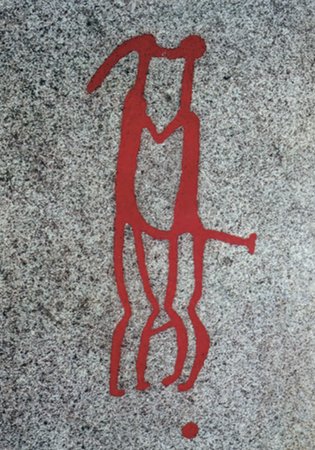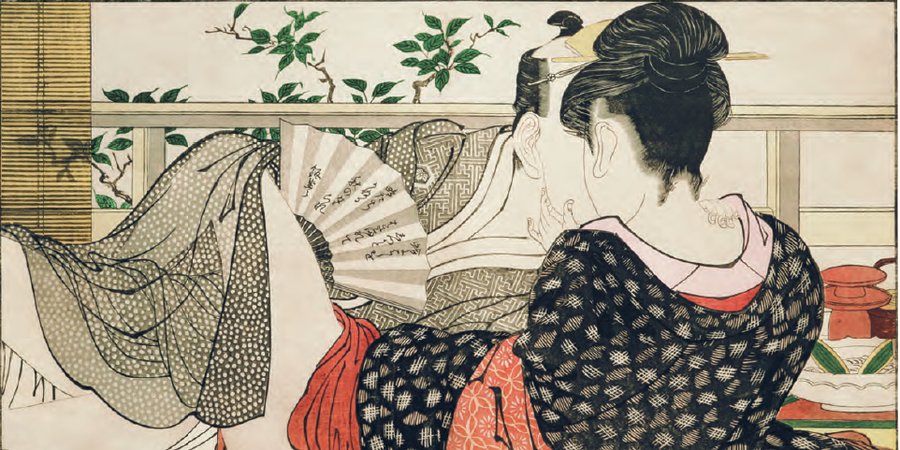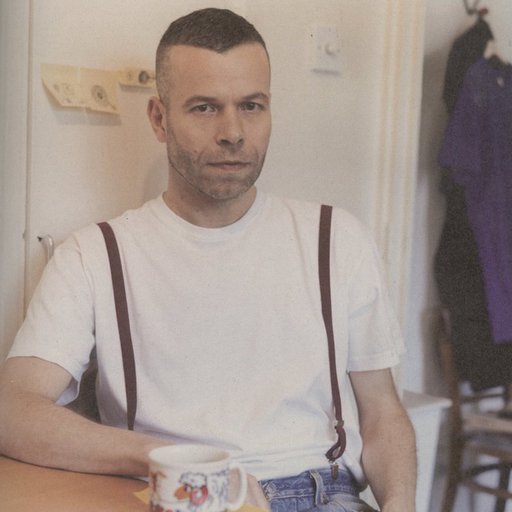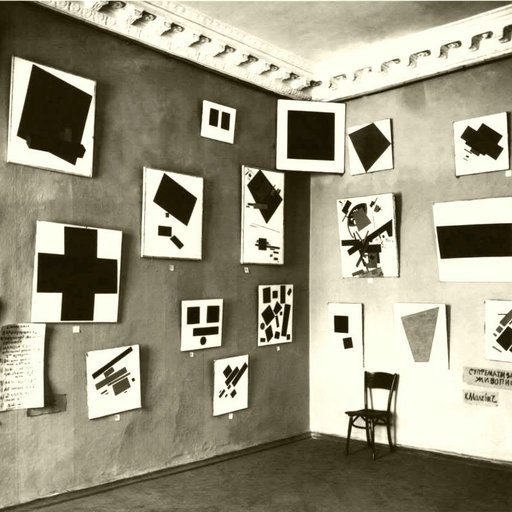From cave paintings to the Vienna Secession and beyond, love scenes have long captured the eye of artists and art lovers alike. Here, we’ve excerpted some of the most important romantic scenes from Phaidon’s revised edition of 30,000 Years of Art . Ranging from prudish to passionate, these representations of love (all heterosexual, sadly—blame the history of art, or read your Foucault ) show the softer side of humanity in all its messiness and glory. Trying to impress an art-conscious crush? This list should give you a leg up.
THE LOVERS
Artist Unknown
Sweden, Bronze Age, c. 1000 BC
In situ, Vitlycke, Bohuslän

Rock art abounds in early Scandinavia and one of the most interesting concentrations is in western Sweden. Particularly noteworthy is the group of carvings at Bohuslän, which displays considerable variety and provides a valuable clue to Swedish Bronze Age (c.1800–500 BC) beliefs and society.
The detail shown here (the bright paint is a modern addition) is an element in an assemblage of engravings that appear to represent the “sacred marriage,” a ritual intended to ensure fertility among livestock on land or (in the case of depictions involving boats) at sea. The two figures embracing and holding hands (the one on the left is assumed to be female) are overseen by a much larger figure with phallus (not shown), brandishing an axe and armed with a sword, who on account of his size may represent a god or possibly a priest. Other associated depictions include one of bestiality, and the representation of a chariot.
Swedish Bronze Age rock engravings remarkably anticipate later Scandinavian art, and include perhaps the earliest depictions of elements in later Viking mythology.
MAY, FROM LES TRÈS RICHES HEURES
Paul, Jean, and Herman Limbourg
France, International Gothic Style, c. 1412
Musée Condé, Chantilly

The three Limbourg brothers from Flanders—Paul, Jean, and Herman —were the most highly regarded of all late Gothic illuminators. Their greatest masterpiece, Les Très Riches Heures , produced for Jean, Duc de Berry, is considered the archetype of the International Gothic style. This was essentially a court style, elegant and sophisticated, combining naturalism of detail with overall decorative effect.
Les Très Riches Heures (1412–1416) is an exceptionally lavish illustrated Book of Hours, a collection of texts for the liturgical hours of the day, intended for private devotion. The brothers’ style is characterized by a painstaking attention to detail, a subtle line, and a vivid sense of narrative. They were pioneers in the depiction of landscapes and genre details, in which northern Italian and Tuscan influence is evident.
This page shows the traditional May Day celebrations, associated with springtime and the celebration of love. The figures wear leaf crowns and necklaces, the women are dressed in May green. The knight in black, white, and red is Jean de Bourbon II, Count of Clermont, who gazes at his wife, Marie, daughter of Jean de Berry. In the background is the Palais de la Cité in Paris, where the couple had married.
SITASAMVARA
Undur Gegeen Zanabazar
Mongolia, Zanabazar Style, c. 1685
Choijin Lama Museum, Ulaan Baatar

The motif of the coupling of the "mother" (Tib.: yum ) and "father" (Tib.: yab ), representing the union of wisdom with the means aimed at attaining nirvana, is embodied by Sitasamvara (or White Samvara) and his consort Vajravarahi. With pots of elixir in them, Sitasamvara’s hands cross in the gesture of the highest energy ( vajrahumkara ) behind the back of his consort, and she repeats the action behind his neck. Such representations of coupling from the world of northern Buddhism is often memorable not only for the drama of iconography but also for the tender and emotive form and spirit of the images. In this sculpture, the deities embrace with a sensuality and delicacy that is immediate and compelling in its appeal. The composition appears to have arrested a moment in the intimacy of the gods, and as their faces almost touch they appear passionate, vital and alive.
The ability to achieve symmetry and precision of detailing while bequeathing his subjects with life is characteristic of the work of Undur Gegeen Zanabazar (1635–1723). In a culture in which it was rare for artists to be personalities, the Mongolian monk and sculptor was recognized and adulated for his skilled craftsmanship and distinctive forms. This sculpture is also remarkable for the impression it gives of a continuous, composite whole; in reality, it was cast in multiple parts that were then joined.
SAKALAVA COUPLE
Artist Unknown
Madagascar
,
Sakalava Culture, c.1700
Metropolitan Museum of Art
, New York

This work, dated to the late seventeenth or early eighteenth century, was created off the coast of East Africa on the island of Madagascar, the cosmopolitan cultural heritage of which represents a synthesis of African and Asian elements. Although its weathered surface and design make it clear that it was originally the finial of an exterior monument, its specific function is unclear. This couple may have surmounted a post that was paired with a nearly identical one now at the Louvre in Paris, both of these positioned at the center of a village as the site of important rites and offerings.
The idea of the fundamental complementarity of man and woman so eloquently depicted in this work is an important theme in Malagasy spiritual life. The male and female figures stand side-by-side in identical stances. Their bodies are closely symmetrical with the man only slightly taller; the woman balances a vessel upon her head. The immediacy of the representation lies in the intense facial expressions, confronting the viewer with their deeply recessed eyes.
There is a deceptive simplicity to this arrangement of unadorned vertical figures, for exacting care has been applied to their rendering as mirror images of each other and to the delicacy of the asymmetry of their relative height. The extent of the composition’s calculated precision is apparent in the column of negative space between the figures echoed by that between their legs.
MR. AND MRS. ANDREWS
Thomas Gainsborough
UK, Rococo Style, c. 1750
National Gallery, London

The double portrait of Mr. and Mrs. Andrews is one of the most celebrated paintings by Thomas Gainsborough (1727–1788). It is often interpreted as a “marriage portrait” and shows Robert Andrews and his wife, Frances, on their estate near Sudbury in Suffolk, two years after their wedding. The painting celebrates both their union and the extensive property recently reunited through their marriage.
The unusual details of a normally generalized landscape draw attention to the good husbandry of Robert Andrews, who was a keen agriculturist. Here the tradition of the “conversation piece” – an informal family portrait or grouping of friends engaged in some favorite occupation in a private setting – is transmuted by the artist. Both the landscape and the sitters are of equal interest, and if Robert Andrews seems well suited to his element, nonchalantly holding a gun, the same cannot be said of Frances Andrews – aged only 18 at the time, she is sitting upright, looking slightly uncomfortable and decidedly less confident. Notably, there is a patch of unfinished painting on her lap, leading to the disputable speculation that it was reserved for a cock pheasant that her husband had just shot.
Painted with elegance and virtuosity, this work stands as a powerful image of the British countryside. Gainsborough, who was trained by the French engraver Hubert François Gravelot and the painter Francis Hayman, proved here that he was one of the most significant artists of his generation.
THE SWING
Jean-Honoré Fragonard
France, Late Rococo Style, 1767
Wallace Collection, London

Jean-Honoré Fragonard (1732–1806) had his work praised by the greatest art critic of the day, Denis Diderot, and achieved professional success until his fortunes declined in the 1770s and 1780s. With his individual techniques in oil, often compared to those of Impressionism, he was revered in the twentieth century as a rare technician whose unorthodox impasto attracted colorists as diverse as Claude Monet and Chaïm Soutine. In his own day, his art was also associated with a sexual explicitness bordering on pornography.
After winning the Prix de Rome in 1752 (an art prize that included an extended visit to Italy), Fragonard travelled to Rome in 1756, where he quickly rebelled against the academic teaching he had received in France, turning instead to the portrayal of life in the Italian countryside. His pastels and oils of beautiful young men and women in opulent interiors, southern landscapes and Mediterranean formal gardens, as here, dotted with cypresses, orange groves and statues, made him the supreme exponent of later Rococo painting.
Having built a reputation for the rapidity of his sketches, a skill implied by the swans down and nipple-pink floss of the exuberantly naughty Swing , the artist further experimented with loose brushwork and the use of such colours as saffron, turquoise, vermilion, rose, and snuff brown, which are rendered particularly well here.
POEM OF THE PILLOW
Kitagawa Utamaro
Japan, Middle Edo Period, Ukiyo-e, 1788
British Museum, London

The Poem of the Pillow is among the finest Japanese erotic albums. Its 12 color woodblock prints include some of the best designs by Kitagawa Utamaro (1753–1806), Japan’s leading artist of passion and refined sensuality. Here, in the tenth print from the set, Utamaro depicts a rendezvous between a guest and a waitress on the second floor of a restaurant. The scene is unusually tender, with the man amorously studying his lover while she gently caresses his cheek, her kimono loosened to allow full view of the nape of her neck—a Japanese erogenous zone. The man’s folding fan, an ordinary personal item, is inscribed with a parody of a classical Japanese poem.
Along with beautiful women and kabuki actors, erotica ( shunga ) formed a major subject of Japanese woodblock prints throughout the early modern period. But this book stands far above the norm, and not only for the superbly conceived images. Every refinement went into the printing, with warm red outlines for the figures instead of the standard black, and precision in the carving of details, especially the hair and the patterns of the robes. The publisher is not named, but the quality of the volume marks it as a product of Tsutaya Juzaburo, the publisher who discovered Utamaro, encouraged his work in different areas, and eventually produced some of his most famous prints.
THE CYCLOPS
Odilon Redon
France, Symbolism, c. 1899
Kröller-Müller Museum, Otterlo, Netherlands

Odilon Redon (1840–1916), one of the major figures in Symbolism, created pictorial evocations of words, transforming poetry and prose into images without allowing literal illustration to impede his imagination. Suggestion and ambiguity are key facets of his work. His early charcoal drawings, the dark lithographs he called Noirs and his oil paintings obsessively explore themes from contemporary poets and writers, as well as ancient mythology. Mythological texts exercised a profound influence on French Symbolist artists. This work (painted between 1898 and 1900) of a Cyclops yearning for the sleeping sea nymph Galatea was probably inspired by a similar subject exhibited by his fellow Symbolist, Gustave Moreau, in the 1880 Paris Salon.
In ancient Greek mythology, the Cyclops were Titans who existed before human beings. According to the Greek poet Homer, they had one large round eye and were shepherds and cannibals; according to the Greek poet Hesiod, they were the sons of Uranus and provided Zeus with thunderbolts. Redon made several studies of Cyclops; here the creature watches his beloved in a mountainous landscape dotted with make-believe flowers. In his exploitation of color, form, light and shadow, the artist expresses the hallucinogenic fantasies of dreams, in which he departs on an imaginary journey to a world of poetry and legend.
THE KISS
Gustav Klimt
Austria, Art Nouveau / Vienna Secession, 1907
Österreichische Galerie Belvedere, Vienna

Gustav Klimt (1862–1918) was the President of the Vienna Secession, a radical group of Austrian avant-garde artists who were active during the late nineteenth and early twentieth centuries. His paintings, murals and graphics exemplify the sinuous, refined, and dazzlingly patterned stylizations of Jugendstil (“youth style”), the Art Nouveau of the German-speaking world. Using this exquisite approach, Klimt addressed a heady symbolism of love, death, transcendence, and nature.
The Kiss (1907–1908) is an iconic statement of Klimt’s mature gold-leaf-encrusted painting technique, influenced by the Byzantine mosaics of Ravenna. A couple embraces on a bed of flowers, surrounded by a glowing starscape. The woman kneels next to the man, possibly implying a ritual with erotic overtones. Their robes are covered with golden circles and panels, intermixed with geometric shapes in case in colors. The painting’s mostly abstract planes surround the human faces and flesh, which, by contrast, are rendered in a highly realistic fashion, attesting to Klimt’s virtuosity as a portraitist.
























